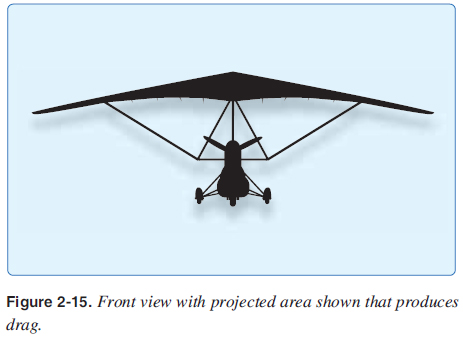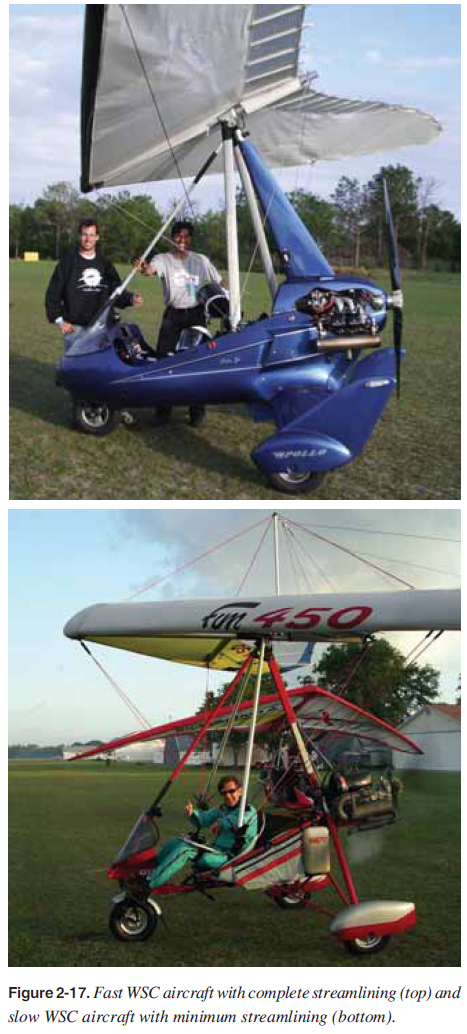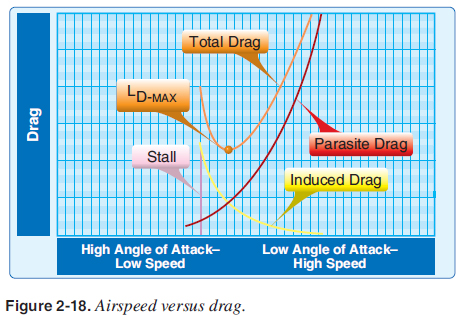
 |
|
||
CHAPTER 2. Aerodynamics Drag Drag is the resistance to forward motion through the air and is parallel to the relative wind. Aerodynamic drag comes in two forms:
Induced drag is the result of lift, and its amount varies as discussed above for lift. Induced drag creates organized circular vortices off the wingtips that generally track down and out from each wingtip. Refer to the Pilot’s Handbook of Aeronautical Knowledge for additional discussion on wingtip vortices formation. These wingtip vortex formations are typical for all aircraft that use wings including WSC, PPC, helicopters, sailplanes, and all fi xed-wing airplanes. The bigger and heavier the aircraft, the greater and more powerful the wingtip vortices are. This organized swirling turbulence is an important factor to understand and avoid for fl ight safety. Refer to the Aeronautical Information Manual (AIM) or the Pilot’s Handbook of Aeronautical Knowledge (FAA-H-8083-25) for additional discussion. Parasite drag is caused by the friction of air moving over all the components of the aircraft. Just as with lift, parasite drag increases as the surface area of the aircraft increases, and dramatically increases as airspeed increases (the square of the velocity). Therefore, doubling the airspeed quadruples parasite drag. [Figure 2-15]  The WSC aircraft can be designed for the purpose of being a slow fl ying aircraft with a large wing where drag is not a major concern, or can be designed to be a fast fl ying aircraft with a small wing where drag is more of a concern. The aircraft has plenty of items (area) for the wind to strike including wing, wires, struts, pilot, carriage, engine, wheels, tubes, fuel tanks, etc. Parasitic drag can be reduced by streamlining the items. Round tubes can be streamlined reducing the drag to one-third, and cowlings can be used to streamline the pilot and the carriage completely, but not without the additional expense and additional weight of the streamlining. Streamlining does make a noticeable difference in the speed and gas mileage of the WSC, especially for the faster aircraft. [Figure 2-16]  With the large speed range of WSC aircraft, weight, complexity, amount and expense of streamlining, and resultant drag reduction are determined by the specific mission for the aircraft and the manufacturers’ make and model. [Figure 2-17]  Total drag is the combination of parasite and induced drag. Total drag = parasitic drag + induced drag To help explain the force of drag, the mathematical equation D = CD x q x S is used. The formula for drag is the same as the formula for lift, except the CD is used instead of the CL. In this equation, drag (D) is the product of the coeffi cient of drag (CD), dynamic pressure (q) determined by the velocity squared times the air density factor, and surface area (S) of the carriage and wing. The overall drag coeffi cient is the ratio of drag pressure to dynamic pressure. Induced and parasitic drag have opposite effects as AOA decreases and speed increases. Note the total drag in Figure 2-18. It is high at the slowest air speeds at high angles of attack near the stall, decreases to the lowest at the most effi cient airspeed, and then progressively increases as the speed increases. The WSC wing can fl y with a large range of airspeeds. Generally, the most effi cient speed is at the lowest total drag providing the best rate of climb, glide ratio, and cruise economy. However, slower speeds provide higher angles of climb, and faster speeds provide quicker transportation. [Figure 2-18]  Weight Weight is a measure of the force of gravity acting upon the mass of the WSC aircraft. Weight consists of everything directly associated with the WSC aircraft in flight: the combined load of the total WSC aircraft (wing, wires, engine, carriage, fuel, oil, people, clothing, helmets, baggage, charts, books, checklists, pencils, handheld global positioning system (GPS), spare clothes, suitcase, etc.). During gliding flight, weight is broken down into two components. The component that opposes the lift, acting perpendicular to fl ight/glide path, and the component that opposes the drag and acts in the direction of the fl ight/glide path. During gliding fl ight, this component of weight is the weight component providing the forward force which some call thrust for gliding fl ight. During gliding, straight, and descending in unaccelerated fl ight: Lift (L) and Drag (D) components = Resultant force (RF) = Weight (W) Total Drag (DT) = Weight component (WD) in the direction of fl ight Lift (L) = Weight component (WL) that opposes lift Similar to airplanes, gliders, and PPC during gliding fl ight, less lift is required because the resultant force composed of lift and drag provides the force to lift the weight. In other words, in gliding fl ight, drag helps support the weight. [Figure 2-19]  |
| ©AvStop Online Magazine Contact Us Return To Books |